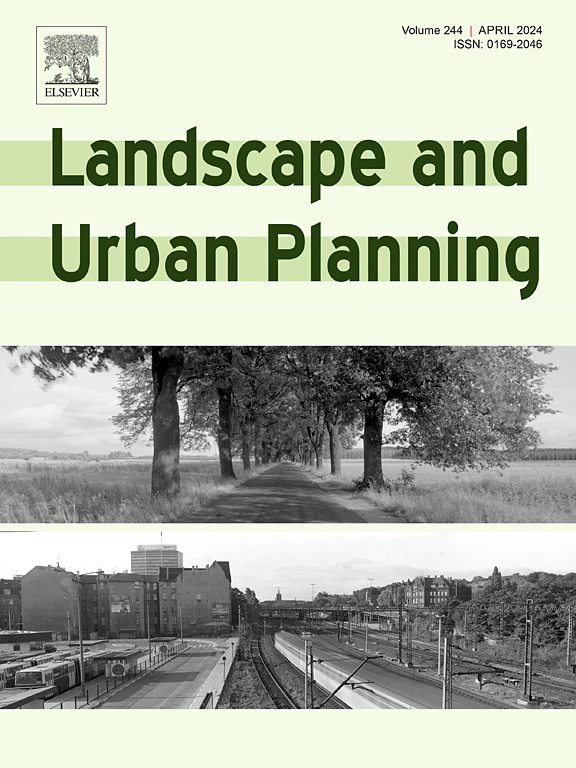设计有效的基于图像的城市视觉感知调查
IF 9.2
1区 环境科学与生态学
Q1 ECOLOGY
引用次数: 0
摘要
城市视觉感知对人类在城市中的体验非常重要,城市景观的特征相互交织。通过量化和解释这些感知体验,研究人员可以深入了解人类的偏好,并为规划和设计决策提供支持。然而,过去的研究表明,调查设计不一致,报告含糊不清,导致对结果的可靠性和可重复性的担忧。本研究提出了第一个综合框架,用于指导基于图像的调查设计,以捕获不同场景下的户外城市环境感知,解决当前研究中缺乏方法标准化的问题。我们回顾了现有的调查,以确定关键参数,进行了全面的主题间和主题内调查,并进行了统计分析,以确定不同背景下调查设计的最佳实践。为了建立一个潜在的社区标准,我们的研究同时也是调查设计报告协议的蓝图。基于结果,我们建议:(1)分别满足李克特量表和两两比较研究中每张图像至少12和22个评级,以达到调查可靠性,并将这些与其他调查设计参数一起报告,以提高透明度和可重复性;(2)当资源允许实验规模较大时,采用Pairwise Comparison等排序方法,使排序结果更加牢固;(3)更频繁地使用透视(非全景)图像,因为它们的总体得分与全景图像相当(R大多为0.7),同时通过众包资源更广泛地获得,支持它们在大规模视觉感知研究中的使用。本文章由计算机程序翻译,如有差异,请以英文原文为准。
Designing effective image-based surveys for urban visual perception
Urban visual perception is important for the human experience in cities, shaped by intertwined characteristics of urban landscapes. By quantifying and explaining these perceptual experiences, researchers can gain insights into human preferences and support decision-making in planning and design. However, past studies have shown inconsistencies in survey design and ambiguities in reporting, leading to concerns about the reliability and reproducibility of results. This study proposes the first comprehensive framework to guide image-based survey design for capturing perceptions of outdoor urban environments across different scenarios, addressing the lack of methodological standardization in current research. We reviewed existing surveys to identify key parameters, conducted comprehensive between-subject and within-subject surveys, and performed statistical analyses to determine best practices for survey design across different contexts. Aiming to set a potential community standard, our study doubles as a blueprint for a reporting protocol for survey designs. Based on the results, we recommend: (1) meeting a minimum of 12 and 22 ratings per image for Likert Scale and Pairwise Comparison studies to reach survey reliability, respectively, and reporting these alongside other survey design parameters to enhance transparency and reproducibility; and (2) when resource allows larger experiments, adopt a ranking method such as Pairwise Comparison to achieve firmer rating results; and (3) using perspective (non-panoramic) images more frequently, as they exhibit comparable overall scores to panoramic images (R mostly ), while being more widely available via crowdsourced sources, supporting their use in large-scale visual perception research.
求助全文
通过发布文献求助,成功后即可免费获取论文全文。
去求助
来源期刊

Landscape and Urban Planning
环境科学-生态学
CiteScore
15.20
自引率
6.60%
发文量
232
审稿时长
6 months
期刊介绍:
Landscape and Urban Planning is an international journal that aims to enhance our understanding of landscapes and promote sustainable solutions for landscape change. The journal focuses on landscapes as complex social-ecological systems that encompass various spatial and temporal dimensions. These landscapes possess aesthetic, natural, and cultural qualities that are valued by individuals in different ways, leading to actions that alter the landscape. With increasing urbanization and the need for ecological and cultural sensitivity at various scales, a multidisciplinary approach is necessary to comprehend and align social and ecological values for landscape sustainability. The journal believes that combining landscape science with planning and design can yield positive outcomes for both people and nature.
 求助内容:
求助内容: 应助结果提醒方式:
应助结果提醒方式:


